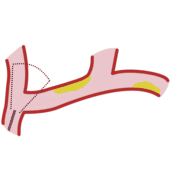
Chronic total occlusions are encountered in >40% of cases during endovascular treatment of peripheral artery disease. Current techniques for steering intravascular devices and visualizing anatomy do not allow direct visualization of the occlusion in order to navigate through calcified chronic total occlusions, resulting in 25% of procedures failing. Given that approximately 3 million people in the United States have peripheral artery disease and one or more chronic total occlusions, a solution for navigating guidewires beyond chronic total occlusions is needed to prevent loss of limb or life with endovascular revascularization. A robotically-steered guidewire with integrated forward-viewing ultrasound guidance to allow crossing chronic total occlusions was developed, consisting of a custom ultrasound transducer bonded to a 0.035’’ robotically-steered guidewire. The fabricated transducer operates with a center frequency of 15.7 MHz, -6 dB bandwidth of 45.4%, and SNR of 31 dB. Images are formed with a synthetic aperture imaging algorithm specific to the guidewire-based system.
This developed sub-millimeter imaging system was used to visualize imaging phantoms and an ex vivo artery. In phantom testing, the forward-viewing, guidewire-based system demonstrated spatial resolution of (0.25 mm ´ 0.12 mm) at a depth of 6 mm. In imaging a pig artery, the system was able to visualize the vessel wall and lumen while navigating the vascular environment. This robotically-steered guidewire with forward-viewing guidance can increase procedural success by navigating across chronic total occlusions that cannot currently be crossed in endovascular procedures. Improved visualization of the vascular environment and guidewire control may also decrease procedure times and rate of iatrogenic injury.

